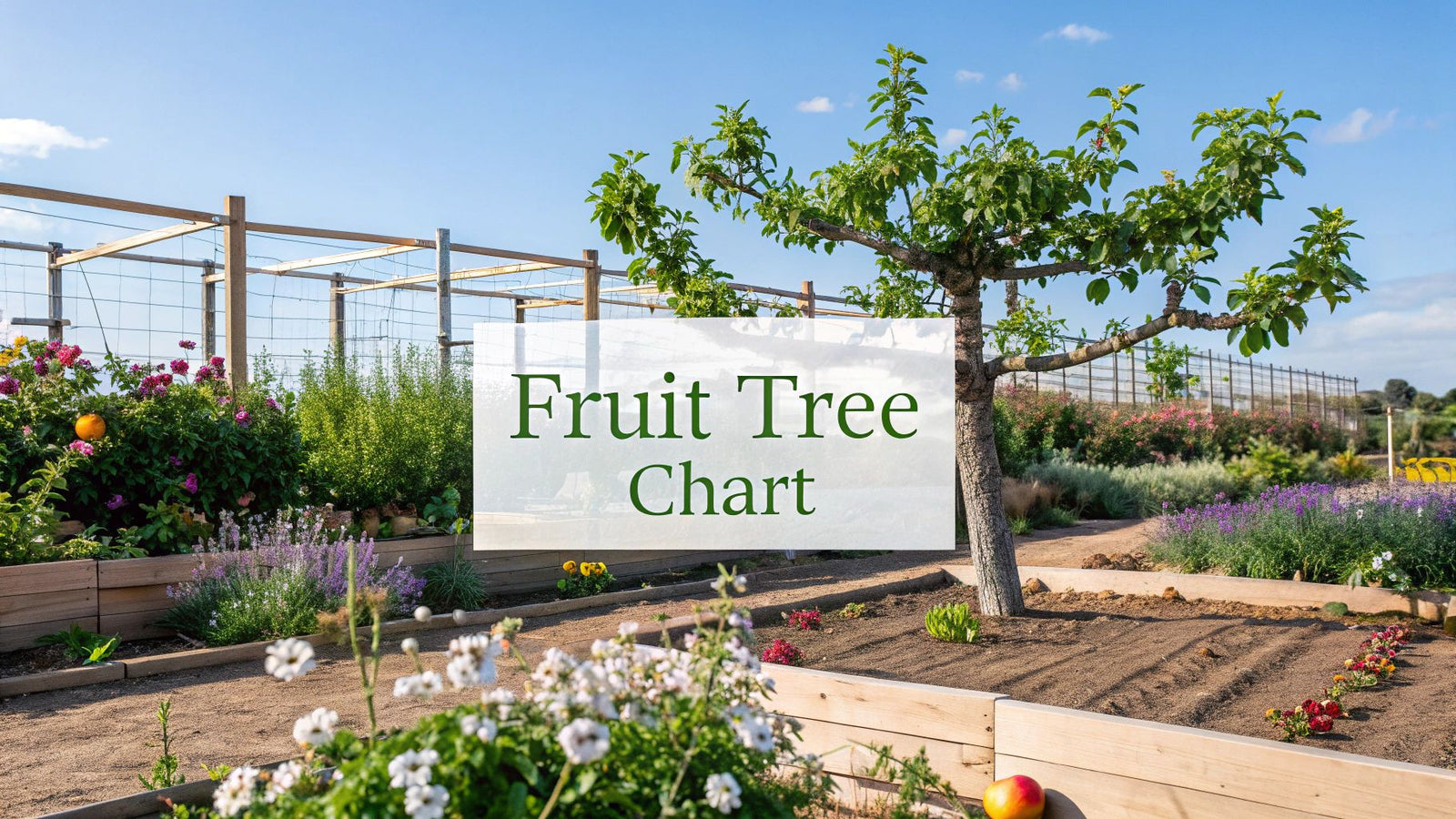
A fruit tree companion planting chart is essentially a matchmaking guide for your garden. It helps you pair your fruit trees with other beneficial plants—think herbs, flowers, and groundcovers—that work together to create a healthier, more productive mini-ecosystem. These pairings can help keep pests away, bring in valuable pollinators, and even improve the soil your trees grow in. It's a foundational strategy for building a thriving, largely self-sufficient orchard.
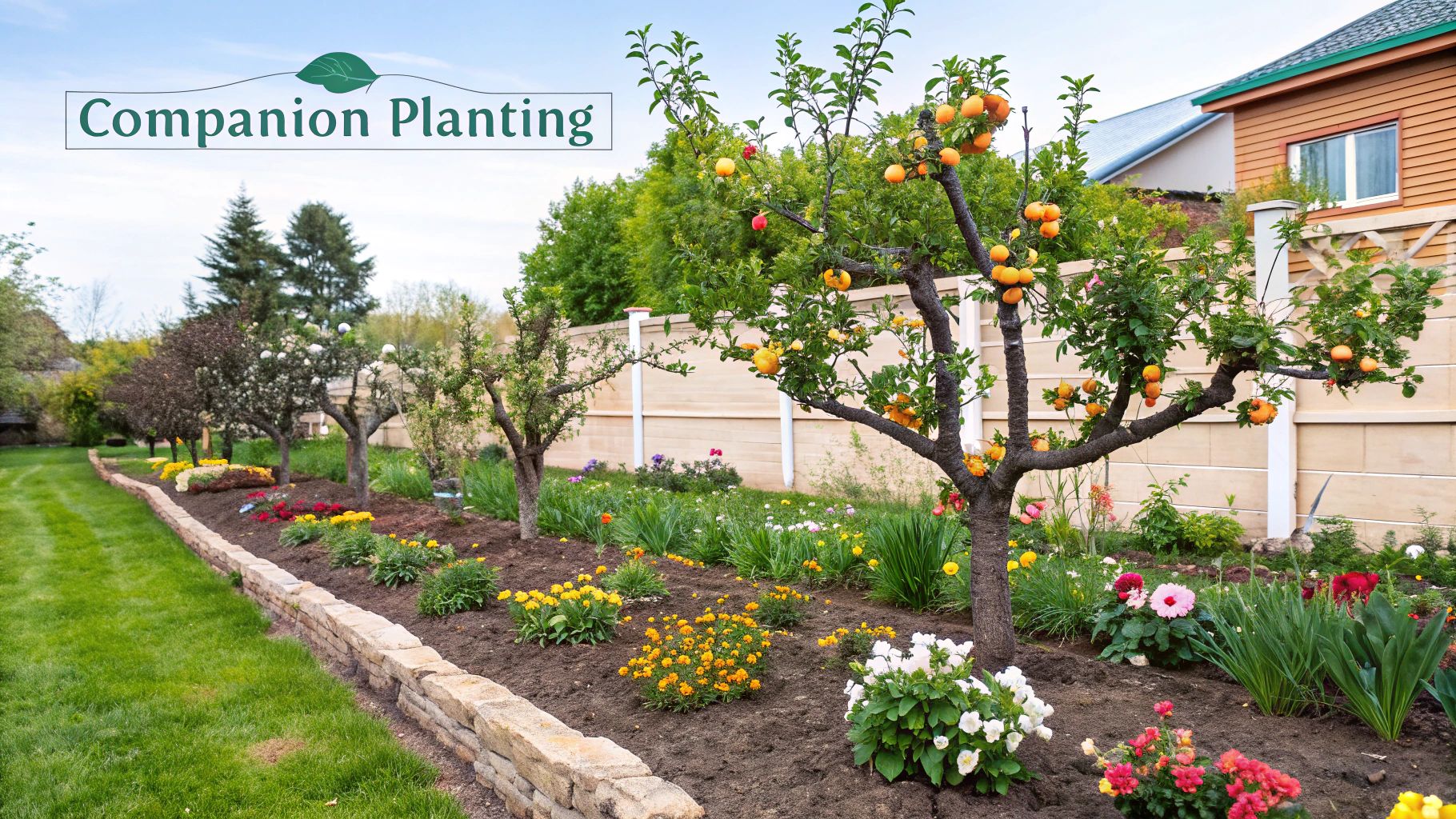
A 5-Minute Guide to Companion Planting for Fruit Trees
At its heart, companion planting is an age-old gardening technique that's all about creating beneficial relationships between different plants. Instead of leaving the earth around your fruit trees bare and exposed, you strategically plant a community that supports the main tree. We often call this arrangement a "fruit tree guild," and it’s a powerful way to build a small-scale ecosystem that practically takes care of itself.
The whole idea is to select plants that provide a specific service. Some might repel harmful insects with their strong aromas, while others fix vital nutrients in the soil. Even if you're just getting started with gardening, this is a very approachable concept. For anyone new to growing, our guide on how to start a garden for beginners offers some great foundational tips.
To help you get started, here's a quick reference table that breaks down the main types of companion plants and the roles they play.
Quick Reference Companion Planting Guide
| Companion Type | Primary Benefit | Example Plants |
|---|---|---|
| Aromatic Herbs | Pest & Disease Control | Lavender, Rosemary, Mint, Chives, Thyme |
| Flowering Attractors | Pollination & Pest Predation | Borage, Calendula, Nasturtium, Yarrow |
| Nitrogen-Fixers | Soil Fertilization | Clover, Vetch, Lupine, Alfalfa |
| Mineral Accumulators | Soil Enrichment | Comfrey, Borage, Yarrow, Dandelion |
| Mulching Groundcovers | Weed Suppression & Moisture Retention | Clover, Creeping Thyme, Strawberries |
This table gives you a bird's-eye view, but let's dig a little deeper into the "why" behind these choices.
3 Core Companion Planting Principles
When you’re choosing companions for your fruit tree guild, you're essentially hiring plants for specific jobs. Here are the 3 main roles you’ll want to fill:
- Pest Deterrents: Think of these as the bouncers for your orchard. Aromatic herbs like lavender, mint, and chives give off powerful scents that confuse and drive away common troublemakers like aphids, codling moths, and even deer.
- Pollinator Attractors: These are your matchmakers. Bright, nectar-rich flowers like borage, comfrey, and calendula are irresistible to bees and other pollinators, which are absolutely essential for a good fruit harvest. They also attract beneficial predatory insects that'll happily snack on any pests that do show up.
- Soil Improvers: These are the caretakers of the soil. Some plants, known as "nitrogen-fixers" (like clover and vetch), have the incredible ability to pull nitrogen from the atmosphere and store it in the soil, creating a free, natural fertilizer for your tree. Others, like comfrey, have deep taproots that act like biological drills, mining minerals from deep in the soil and bringing them to the surface for the tree to use.
11 Benefits of Creating a Thriving Fruit Tree Guild
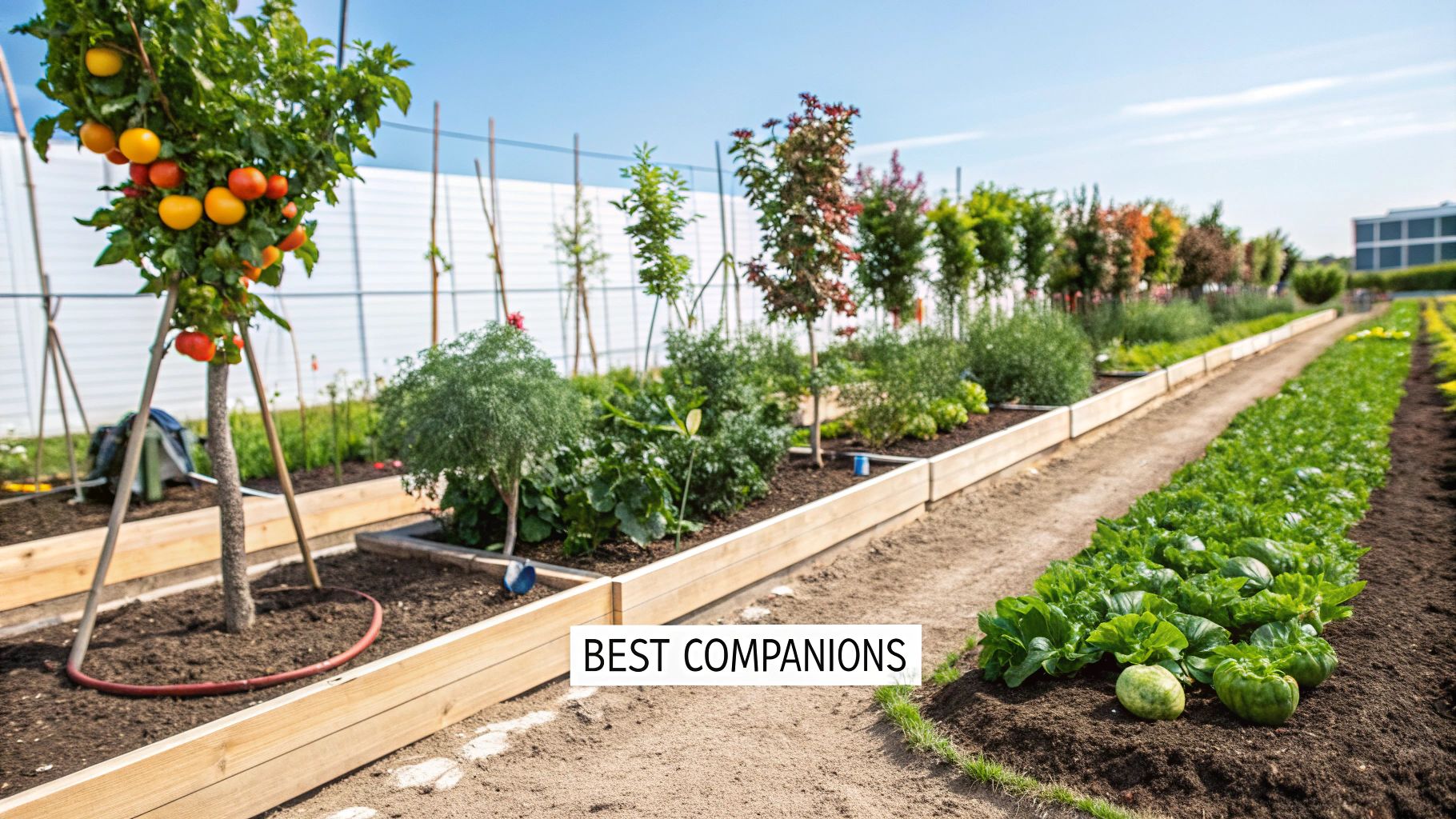
When you plant a fruit tree guild, you’re doing so much more than just putting a tree in the ground. You're creating a small, cooperative community of plants that all work together. Think of it as building a tiny, productive forest floor that supports your main tree from the ground up. This strategic approach to companion planting creates a resilient, largely self-sustaining ecosystem that offers benefits far beyond simple aesthetics.
The advantages are real and they multiply over time. By surrounding your fruit tree with the right companions, you're building a healthier environment that can dramatically improve its vitality and yield, all while making your own gardening efforts more sustainable and rewarding.
Boost Soil Health and Fertility in 3 Ways
One of the most powerful benefits of a fruit tree guild is the constant, natural improvement of your soil. Instead of relying on bags of fertilizer, you can let the plants themselves enrich the ground your tree depends on. It's a living system.
Here’s how a guild works to build amazing soil:
- Nitrogen Fixation: Plants from the legume family, like clover and vetch, are true powerhouses. They have a unique ability to pull nitrogen from the atmosphere and "fix" it into the soil, providing a free, slow-release source of this crucial nutrient for your tree.
- Nutrient Accumulation: Deep-rooted plants like comfrey and borage are what we call "dynamic accumulators." They act like biological miners, tapping into minerals deep in the subsoil that are out of reach for the tree's shallower roots. As their leaves break down, these minerals become available right where the tree needs them.
- Improved Soil Structure: A variety of different root systems in the guild works wonders for soil texture. They naturally break up heavy, compacted earth, which improves aeration and allows water to penetrate deeply instead of running off the surface.
Implement Natural Pest and Weed Control
A well-planned guild is your best ally against the most common orchard headaches. Many companion plants are famous for their ability to deter pests and outcompete weeds, significantly cutting down on your garden chores.
For example, companion planting is a well-documented ecological tool for managing pests. A major analysis covering 552 separate experiments confirmed that farmscaping—using companion plants to shelter beneficial predators like ladybugs and lacewings—consistently lowers pest populations and reduces the need for chemical intervention.
A thriving guild creates a beautifully balanced ecosystem where good bugs keep the bad bugs in check. It's nature's own integrated pest management, working for you 24/7.
The list of benefits goes on. Here are the 11 key advantages you can expect:
- Boosts Soil Fertility
- Improves Soil Structure
- Suppresses Weeds
- Conserves Water by creating a living mulch that shades the soil.
- Attracts Pollinators like bees and butterflies to ensure good fruit set.
- Deters Harmful Pests through confusing scents or by acting as trap crops.
- Creates Habitat for Beneficial Insects
- Reduces Fungal Diseases by promoting better air circulation around the tree's base.
- Increases Biodiversity in your backyard.
- Provides Secondary Yields of herbs, flowers, or even vegetables.
- Reduces Overall Maintenance once the guild becomes established.
These core ideas are fundamental to smart gardening, and they don't just apply to trees. Many of the same principles can help you create a more productive vegetable patch. To see how, check out our guide on which vegetable seeds go well together.
The 7 Layers of a Successful Fruit Tree Guild
When you're building a fruit tree guild, you're not just planting a random assortment of things around a tree. What you're really doing is creating a small, thriving ecosystem designed to mimic the layers you'd find in a natural forest. Thinking in these layers is fundamental to any good companion planting strategy, and it’s what turns a simple orchard into a self-sustaining powerhouse.
Each of the seven layers has a specific job, whether it's feeding the soil, warding off pests, or attracting helpful insects. When they all work together, you get a resilient, productive, and surprisingly low-maintenance system that supports your main tree while giving you bonus harvests of herbs, flowers, and berries.
This image breaks down the concept beautifully, showing the fruit tree as the anchor for a whole community of beneficial plants.
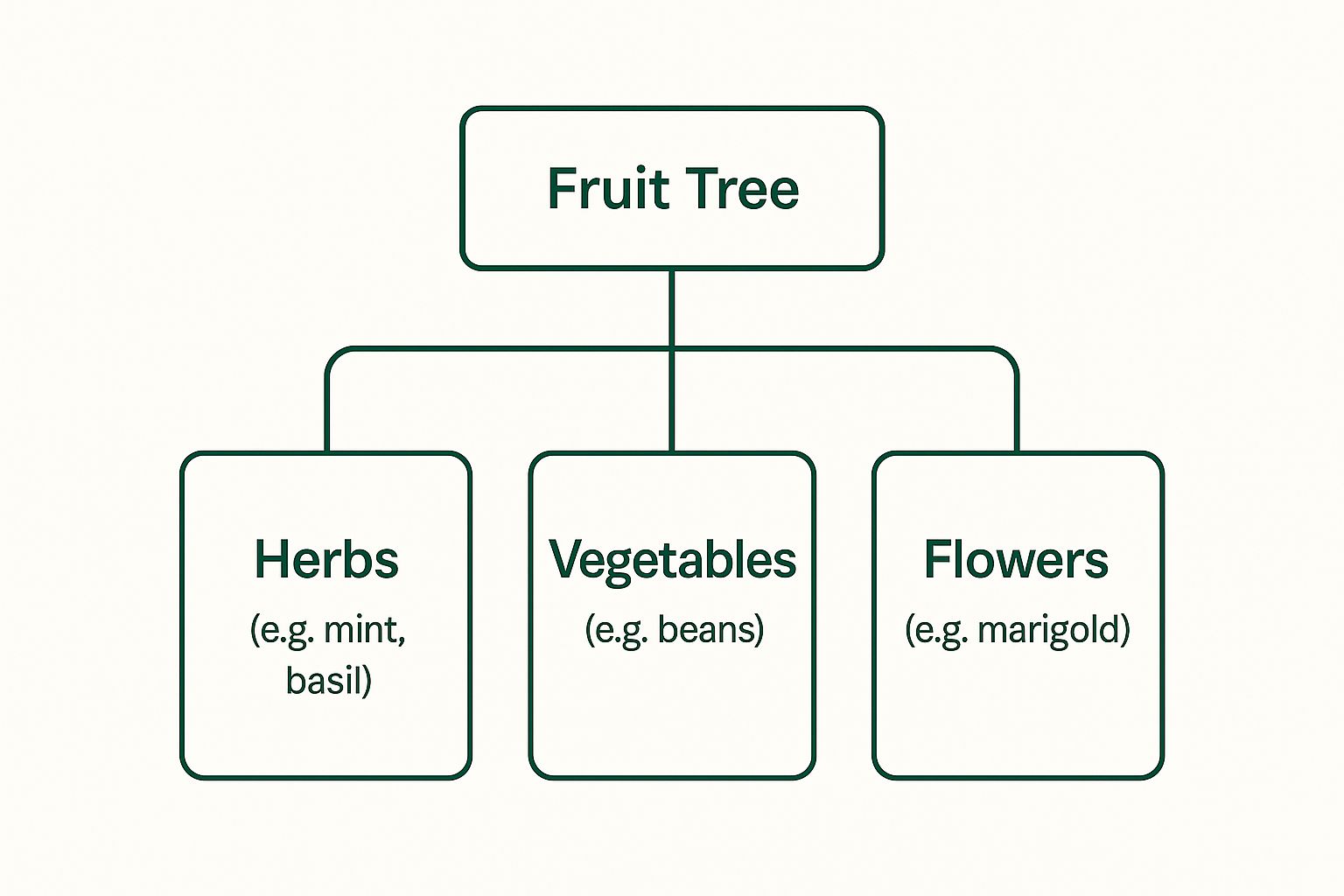
As you can see, the most effective companion plants are often a mix of herbs, vegetables, and flowers, and each one brings something unique to the table.
Layers 1 to 3: The 3 Foundational Guild Layers
Think of these first three layers as the bedrock of your guild. They establish the physical structure and, just as importantly, the health of the soil itself. This is where you put in the main tree, its supporting cast of shrubs, and the all-important soil-builders.
- The Central Fruit Tree: This is your canopy layer and the reason for the whole guild. Every other plant you choose from here on out is selected specifically to help this tree thrive.
- Smaller Shrubs or Bushes: Tucked in around the main tree, these plants often produce berries and are fantastic at attracting birds, which are your first line of defense against many insect pests. Currants and gooseberries are great choices because they don't mind the partial shade cast by the fruit tree.
- Nitrogen-Fixing Plants: Honestly, this might be the most critical layer for long-term soil fertility. Plants like clover, lupine, and vetch have the incredible ability to pull nitrogen right out of the air and "fix" it in their root systems. This creates a slow-and-steady, free source of fertilizer for your tree.
A well-designed guild is all about creating a self-sufficient system. When you integrate nitrogen-fixers and plants that provide mulch, you dramatically cut down on your need for store-bought fertilizers and endless weeding. You're letting nature do the heavy lifting.
Layers 4 to 7: The 4 Protective Guild Layers
With the core of your guild in place, it’s time to add the layers that protect it, ensure good pollination, and provide support at ground level. These are the plants that actively defend the tree and help guarantee you get a great harvest.
- Pest-Repelling Aromatic Herbs: Pests often find their targets by scent, and pungent herbs are perfect for throwing them off. Strong-smelling plants like mint, lavender, chives, and rosemary create an aromatic smokescreen that can hide your fruit tree from destructive insects.
- Mulch-Providing Plants: Comfrey is the undisputed king of this layer. Its big, nutrient-rich leaves can be chopped down a few times a season and left right on the ground. This "chop-and-drop" method creates a living mulch that smothers weeds, holds in moisture, and slowly releases nutrients back into the soil as it breaks down.
- Pollinator-Attracting Flowers: No bees, no fruit. It's that simple. Planting a variety of flowers like borage, calendula, and yarrow ensures there’s a steady stream of happy pollinators visiting your guild, especially when your fruit tree is in bloom.
- Weed-Suppressing Groundcovers: The final touch is a living carpet to cover any bare soil. This layer is all about preventing weeds from gaining a foothold and competing for water and nutrients. Low-growing plants like creeping thyme or wild strawberries are excellent choices for blanketing the ground.
Companion Planting Chart for 3 Common Fruit Tree Types
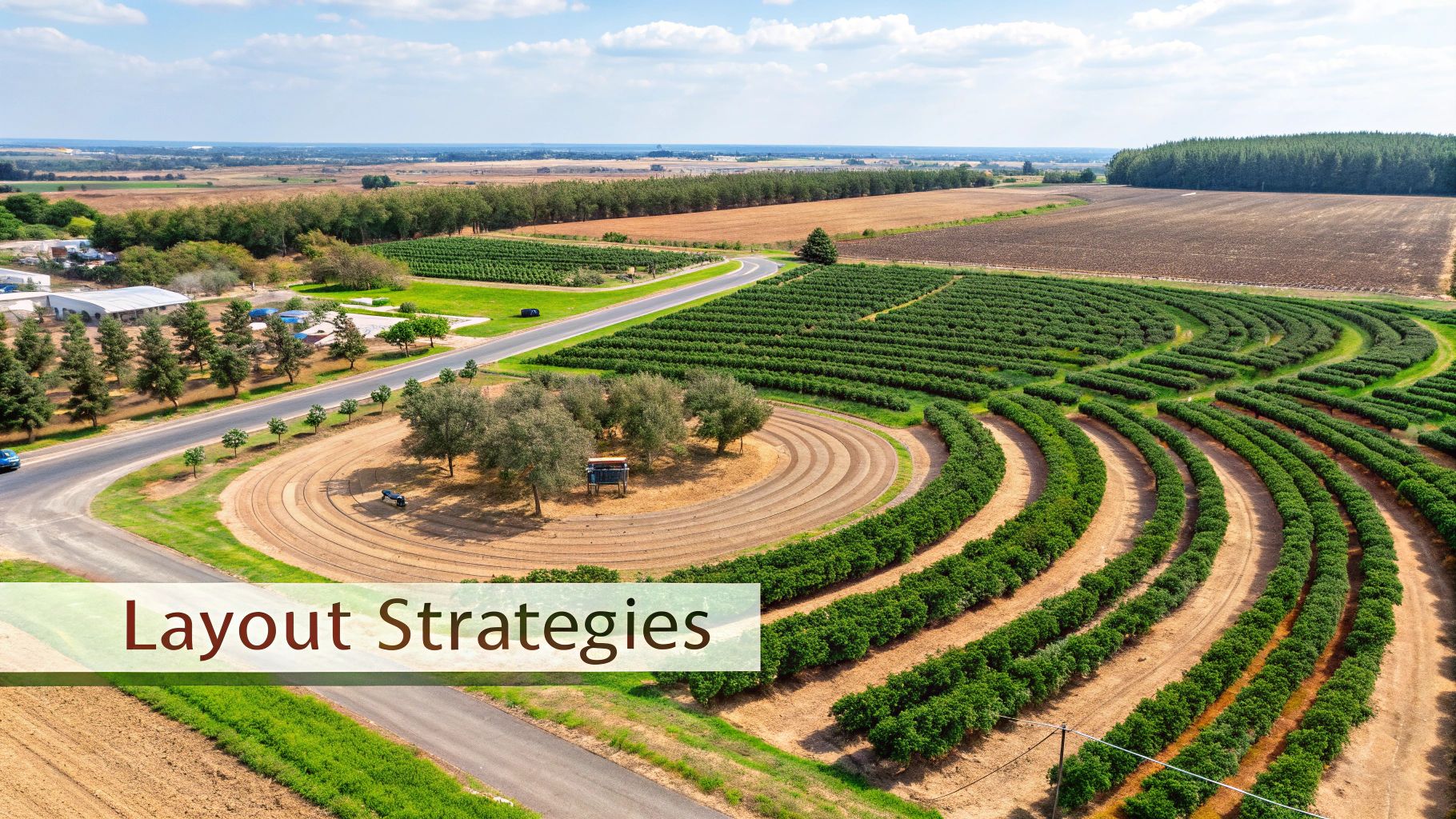
Not all fruit trees are created equal, and their needs can vary dramatically. This means a one-size-fits-all approach to companion planting just won't cut it if you're serious about results. To build a truly thriving ecosystem, or "guild," around your trees, you need a fruit tree companion planting chart that considers the unique challenges of what you're growing.
For instance, pome fruits like apples are constantly under attack from codling moths, while stone fruits like peaches are a prime target for borers. A carefully selected companion plant can tackle these specific problems head-on. This isn't just about making your garden look pretty; it’s a smart, ecological strategy for building a more resilient orchard.
This kind of thinking has a much bigger impact, too. With the United Nations classifying nearly 50% of global farmland as degraded, our food systems are under pressure. By integrating diverse fruit trees with their companions, we can help restore soil health and support the pollinators responsible for an incredible 35% of global food crop yields. If you're interested in the bigger picture, Renature.co has some great insights on how these practices strengthen food security.
4 Best Companions for Pome Fruits (Apples and Pears)
When planting around apples and pears, the main goals are to fend off common pests like aphids and codling moths and to improve the soil. The right companions create a guild that protects the tree while making its home a better place to grow.
- Chives & Garlic: I plant these all the time. Their strong, oniony scent is fantastic for confusing and repelling pests like apple aphids. A ring of chives around the tree's drip line acts as a simple but effective aromatic barrier.
- Daffodils: These are non-negotiable in areas with gophers or voles, as they deter these rodents from gnawing on the tree's trunk and roots. They also help keep fruit tree borers away.
- Nasturtiums: Think of these as a sacrificial offering. Nasturtiums are a classic "trap crop" that lures aphids away from your precious fruit trees. As a bonus, they also help deter codling moths.
- Comfrey: This is a powerhouse plant. Known as a dynamic accumulator, comfrey's deep taproot pulls up nutrients other plants can't reach. Simply chop the leaves and drop them as a nutrient-dense mulch around your trees.
3 Top Companions for Stone Fruits (Peaches, Cherries, Plums)
Stone fruits are notoriously susceptible to borers and fungal diseases. So, for peaches, cherries, and plums, we want companions that repel these specific threats and help improve air circulation to keep fungus at bay.
- Marigolds: A garden classic for a reason. Marigolds release compounds into the soil that deter harmful nematodes and also repel many above-ground pests, including some borers.
- Tansy: This is an old-timer's trick for pest control. Tansy is fantastic for warding off flying insects, especially the dreaded peach tree borer. Just be careful—it can spread aggressively if you don't keep an eye on it.
- Lavender: The beautiful, fragrant spikes of lavender do more than just look and smell great. Their strong scent is a powerful deterrent for moths and other pests, all while attracting a whole host of beneficial pollinators to your orchard.
When it comes to stone fruits, I always focus on aromatic herbs. The goal is to mask the tree’s scent from pests. A well-placed border of lavender or marigolds can make a world of difference in preventing an infestation before it starts.
3 Great Companions for Citrus Fruits (Lemons, Oranges, Limes)
Citrus trees are heavy feeders that need plenty of nitrogen to thrive. The ideal companions will help feed the soil while also drawing in pollinators and beneficial insects that act as a natural pest control squad.
- Legumes (Peas & Beans): These are nitrogen factories. Planting legumes like peas and beans around your citrus trees is a fantastic way to naturally fix nitrogen in the soil, giving your trees the nutrient boost they crave.
- Borage: Those brilliant blue flowers are an absolute magnet for bees and other pollinators. Borage is also a great mineral accumulator, enriching the soil as its leaves break down.
- Marigolds: Yes, them again! Just as with stone fruits, marigolds are a citrus grower's best friend for tackling nematodes below the soil and other common pests above ground.
9 Plants to Avoid in Your Fruit Tree Guild
While we've focused on all the great plants to pair with your fruit trees, knowing what not to plant is just as crucial. Some plants are what we call "antagonistic," meaning they actively work against your trees. They might compete too aggressively for water and nutrients, attract the wrong crowd of pests, or even release chemicals into the soil that inhibit growth—a process known as allelopathy.
Steering clear of these antagonistic plants is a non-negotiable part of building a thriving home orchard. A single bad neighbor can easily undermine all the benefits you've gained from your carefully chosen companion plants, so it pays to be selective about what grows near your tree's trunk.
2 Big Reasons Some Plants Are Bad Neighbors
So, what makes a plant a "bad neighbor"? It really boils down to two main issues: intense competition and allelopathy. Some are simply greedy, acting as heavy feeders that suck up all the available nitrogen and water from your tree's root zone. Others are more insidious, releasing subtle toxins that can stunt a tree's growth over time.
Research backs this up, showing that companion planting directly influences everything from soil microbes to nutrient availability, for better or for worse. The right pairings can boost a tree's ability to absorb nutrients, while the wrong ones create a competitive environment that leaves the tree weak and struggling. If you're curious about the science, you can read more about how intercropping affects soil health and see just how deep these relationships go.
Here are 9 common plants you should think twice about planting within your fruit tree guilds.
-
Black Walnut: This is the most notorious bad neighbor in the plant world, especially for apple trees. Black walnuts produce a powerful chemical called juglone, which is highly toxic to a wide range of plants. It can cause wilting, stunted growth, and eventually, death in sensitive species.
-
Potatoes: It's risky to plant potatoes near your fruit trees. They are magnets for pests and are notoriously susceptible to blight, a nasty fungal disease that can easily spread to your trees.
-
Tomatoes: Just like potatoes, tomatoes are part of the nightshade family. They can host and spread diseases like blight and verticillium wilt, which can devastate the root and vascular systems of stone fruits like cherries and peaches.
-
Most Grasses (Lawn Turf): That neat-looking ring of lawn grass around your tree is a huge mistake. Standard turf is a fierce competitor, creating a dense, shallow root mat that robs a tree of precious water and nitrogen. Letting grass grow right up to the trunk is one of the most common reasons young trees fail to thrive.
-
Fennel: While fennel has its merits for attracting some beneficial insects, it has a reputation for being a bit of a bully. It's known to inhibit the growth of many nearby plants through allelopathy, making it a poor team player in a mixed planting guild.
-
Brassicas (Cabbage, Broccoli, Cauliflower): This entire family of vegetables is full of heavy feeders. Plant them too close to a fruit tree, and they'll get into a fierce competition for essential soil nutrients, a battle your tree might lose.
-
Corn: As a tall and hungry crop, corn casts a lot of shade and competes heavily for sunlight, water, and nutrients. It also attracts its own set of pests, like rootworms and earworms, which can sometimes decide your fruit trees look like the next best meal.
Key Takeaway: If you remember only one thing, make it this: never plant anything known to produce growth-inhibiting toxins near your trees. Black walnut is the most dramatic example, but other plants can have subtle negative effects that compound over time.
And finally, here are two more common garden plants that are best kept at a distance.
-
Rosemary: Although you'll sometimes see rosemary recommended as a pest deterrent, its aggressive and sprawling root system can be a real problem for young or shallow-rooted fruit trees. If you love rosemary, it's best to keep it in a pot or plant it well away from your tree's drip line.
-
Asparagus: Asparagus is a long-term commitment. As a perennial, it establishes a dense, permanent clump of roots that is nearly impossible to manage around a tree. Over the long haul, it will consistently compete for water and nutrients, making it a less-than-ideal companion.
3 FAQs on Fruit Tree Companion Planting
Jumping into companion planting always sparks a few good questions. While a solid fruit tree companion planting chart gives you a great roadmap, knowing how to apply it in your own garden is what really makes the difference. Nailing the details is how you get your little orchard ecosystem to truly thrive.
Let's dig into some of the most common questions we hear from gardeners who are setting up their first fruit tree guilds. This should help you turn all that theory into a successful, living system.
1. How Close Should I Plant Companions to My Fruit Tree?
Spacing is everything, and it really comes down to what job the companion plant is doing and what its root system looks like. As a general rule of thumb, it's best to plant most companions outside the tree’s drip line—that’s the circle on the ground directly beneath the tree's outermost branches. This helps you avoid a turf war for water and nutrients, which is especially important when your fruit tree is still young.
Of course, there are exceptions to every rule:
- Living Mulch: Groundcovers are the exception. Plants like white clover or creeping thyme can grow right up to the trunk. Their whole purpose is to cover the ground, keep weeds down, and hold in moisture.
- Pest Deterrents: I like to plant aromatic herbs like chives, or pest-repelling bulbs like daffodils, in a ring just inside or right along the drip line. This creates a fragrant barrier that confuses pests looking for your tree.
- Nutrient Accumulators: For deep-rooted plants like comfrey, you’ll want to plant them a bit further out, right around the drip line. This gives their powerful roots room to pull up nutrients from deep in the soil without getting tangled up in the tree's main root zone.
2. Can I Use the Same Companions for All My Fruit Trees?
You can, but you shouldn't. It’s tempting to find a few "all-star" plants and just repeat the formula, but you'll get much better results if you tailor the guild to the tree. Every fruit tree has its own unique needs and challenges. For instance, peaches are notorious targets for borers, so planting tansy nearby is a fantastic defensive move. An apple tree? It has different problems, so tansy isn't nearly as critical.
Always think custom. A guild for an apple tree should focus on things that deter codling moths. A guild for a lemon tree, on the other hand, needs plants that are great at fixing nitrogen to feed its hungry, fruit-producing habit. This targeted approach is where the real magic happens.
3. How Long Does It Take for Companion Planting to Show Results?
Gardening teaches patience, and companion planting is no exception. Some benefits, like seeing fewer weeds because you planted a thick groundcover, show up pretty quickly. But the really big payoffs—the stuff that makes your orchard truly resilient—take time. It can easily take 2-3 years for a fruit tree guild to fully mature and for that rich soil ecosystem to hit its stride.
You’ll definitely see more pollinators show up in the very first season. But the deeper benefits, like improved soil fertility and a healthy, balanced population of beneficial insects, build up over several years. If you've got more questions on your mind, you can find answers to other frequently asked questions that pop up for fellow gardeners.
At Homegrown Garden, we're here to give you the heirloom seeds and real-world advice you need to build a garden that truly thrives. Ready to start your perfect fruit tree guild? Check out our curated seed collections at https://www.homegrown-garden.com.



